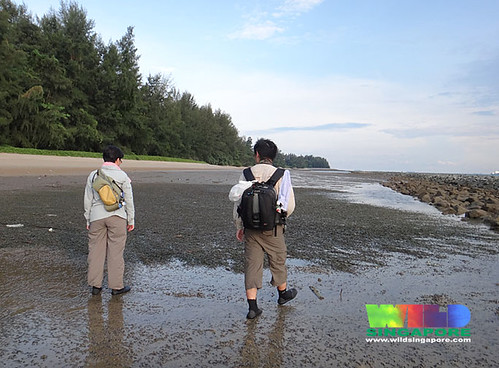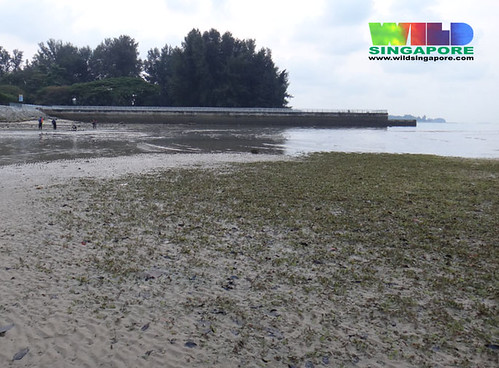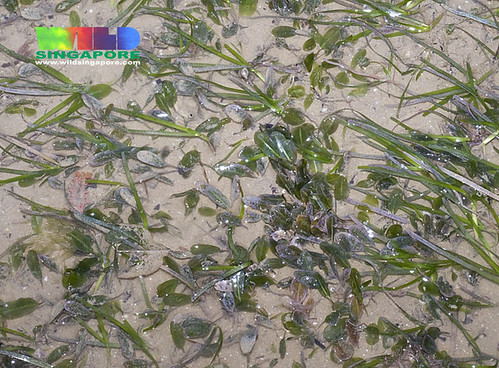More amazingly, these seagrasses survived the massive oil spill of May 2010 that hit this stretch of shore! Lush seagrasses were also recently seen at artificial shores of East Coast Park, and have been seen in the recent past as well. Can we encourage similar natural regeneration on other stretches of artificial shores?! These details are part of City in a Reef: my feedback on the Draft Master Plan 2013.
At Tanah Merah, there are two large patches of Critically Endangered Smooth ribbon seagrasses (Cymodocea rotundata), which are also found only at Chek Jawa and Cyrene Reef. The structure of the lagoon may have helped to allow the seagrasses to settle here naturally. A shallow sheltered sandy lagoon protected by seawalls with natural vegetation on the shore.
The seagrasses are dotted with many living Haddon's carpet anemones (Stichodactyla haddoni) and home to a variety of small creatures such as hermit crabs, snails and fishes, and recently sea cucumbers too! Three other species of seagrasses have settled on this artificial shore: Spoon seagrass (Halophila ovalis), Tape seagrass (Enhalus acoroides) and Critically Endangered Sickle seagrass (Thalassia hemprichii).
Although the massive oil spill of May 2010 had initial severe impact, the seagrasses and most of the marine life there seemed to have survived. The clump of Tape seagrass there bloomed many times despite the oil spill, during the monthly checks on the shore that I conducted from 2010 to 2012.
 |
| Blooming Tape seagrasses with oil slick on the water. |
Lush seagrasses were also seen growing at the artificial shores of East Coast Park in Jun 2013.
Mostly Spoon seagrass (Halophila ovalis) and Needle seagrass (Halodule sp.) which were home to many humungous sea stars, colourful sea cucumbers and rarely seen Fig snails (Ficus variegata).
This shore reminds me of the stretch of artificial shore next to the Marina Barrage where mangroves had settled. When we visited in Dec 2008, we also saw patches of Spoon seagrass (Halophila ovalis) and Needle seagrass (Halodule sp.) and one clump of Tape seagrass (Enhalus acoroides). Shortly after, the area was off limits due to construction of the Marina Coastal Expressway, which ostensibly destroyed the seagrasses.
In fact, we even saw lush growths of Needle seagrass (Halodule sp.) in the lagoon used for wakeboarding at East Coast Park in Jun 2009!
Although we have yet to see signs of dugong feeding trails on the seagrasses growing on these artificial shores, we have regularly seen dugong feeding trails on seagrass meadows growing elsewhere in Singapore.
Where do these seagrasses come from? Where are the natural seagrass meadows that produce the seeds which settled on these artificial shores? What can we do to encourage similar natural regeneration on other stretches of artificial shores? These are indeed very interesting questions that hopefully can be explored in the future by people far more competent than I.
Why should we care about seagrasses growing on our artificial shores?
Seagrasses and other natural ecosystems such as corals and mangroves can help maintain good water quality. They can be living 'barriers' that may help mitigate impacts of rising seas and climate change: such as flooding, saltwater intrusion into freshwater supplies, and impacts of more severe weather. Natural and wild ecosystems that are self-generating and self-sustaining are relatively inexpensive to maintain and provide a wider spectrum of experiences compared to manicured gardens. They can be beautiful and provide recreational enjoyment. Easy access will allow schools bountiful opportunities for nature-related learning. I am sure there are many more advantages that I have not thought of!
These details are part of City in a Reef: my feedback on the Draft Master Plan 2013.
Related links
Surveys to check up on seagrasses that settled naturally at East Coast Park
- East Coast Lagoon is alive! Jun 2009
- East Coast Surprise: Lots of seagrasses! Jun 2013
- Strange snails, huge stars and other surprises, Dec 2008
Surveys to check up on Tanah Merah artificial shores
- I conducted surveys every month here since 2010 to check on the oil spill impact. The posts on these trips are labelled tanah merah.








